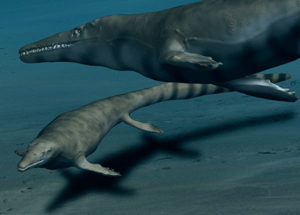
RAPID CITY, S.D. (AP) – James Martin, executive curator of South Dakota School of Mines & Technology’s Museum of Geology, said he has been looking for something like this for a very long time.
There are plenty of mosasaur fossils found in South Dakota, but the specimen found in September by a team of School of Mines paleontologists included not just the animal’s fossilized skeleton, but also its lunch.
“It’s one of the finest I’ve seen in many, many years, mostly because it is so well put together. It’s still in life position,” Martin said. “To find the jaws even still on the cranium is a pretty cool thing. We’ve got not only the jaws, but we’ve got much of the entire back bone series, as well as the ribs.”
This fossil also includes the contents of the animal’s stomach – its last meal. This particular specimen was a fish-eating mosasaur. It also has some of the soft tissue still preserved, which does not happen very often, Martin said.
“There is cartilage still on the shoulder blade and on a bone called a coracoid.”
It isn’t uncommon for paleontologists to find fossils of mosasaurs in South Dakota. The prehistoric giants were abundant in this part of the country 80 million years ago, when an inland sea covered South Dakota.
Laura Scott, a master’s degree School of Mines student studying paleontology, agrees that the 10-foot-long fossil is remarkable.
“This one specifically is amazing because of its condition and the ease of excavation,” Scott said. “Ease for paleontology is a four-month project versus a three-month project. And this is exactly how he laid in the surface,” she said motioning to the nearly complete fossil. “It took less than a week to excavate.”
The fossil was discovered by chance near Chamberlain after Martin’s team had just finished covering another mosasaur specimen they had been working on to prepare it for winter. James Lindley, natural resource specialist for the U.S. Army Corps of Engineers in Chamberlain, suggested they stop at a location along the Missouri River bluffs where Martin had found another huge mosasaur six years earlier.
It was Lindley who spotted this one first.
“I’d never seen anything like that before,” Lindley said. “Virtually the whole thing was exposed. It was laying there articulated, and it was in a serpentine fashion like it was swimming even though it had been dead for 80 million years.”
Martin said the river’s high water level had washed the specimen out.
“Nature had pretty well prepared it, which is very unusual,” he said. “I am amazed at the preservation and how complete it really is.
Mosasaurs are not dinosaurs, Martin said; they are true lizards and known for being “terrors of the sea.”
“This particular specimen ate fish, but there were some that ate anything, including each other.”
Martin said after a little more work, the specimen will be ready for display. It will be on display in the atrium of the new Paleontology Research Laboratory, which opened Sept. 1. The fossil will eventually be moved to the campus’ Museum of Geology, which is temporarily closed for construction. Martin said it should reopen in early November.
Martin said he has been working with the Corps since 1989, and this find is the result of state and federal cooperation. Fossils found on public land are public property and require a federal collecting permit for removal.
“You can’t go out there and just take away things. It’s a national resource, and is protected as such.”
___
Information from: Rapid City Journal, http://www.rapidcityjournal.com
Copyright 2010 Associated Press. All rights reserved. This material may not be published, broadcast, rewritten, or redistributed.
AP-WS-10-30-10 0101EDT

